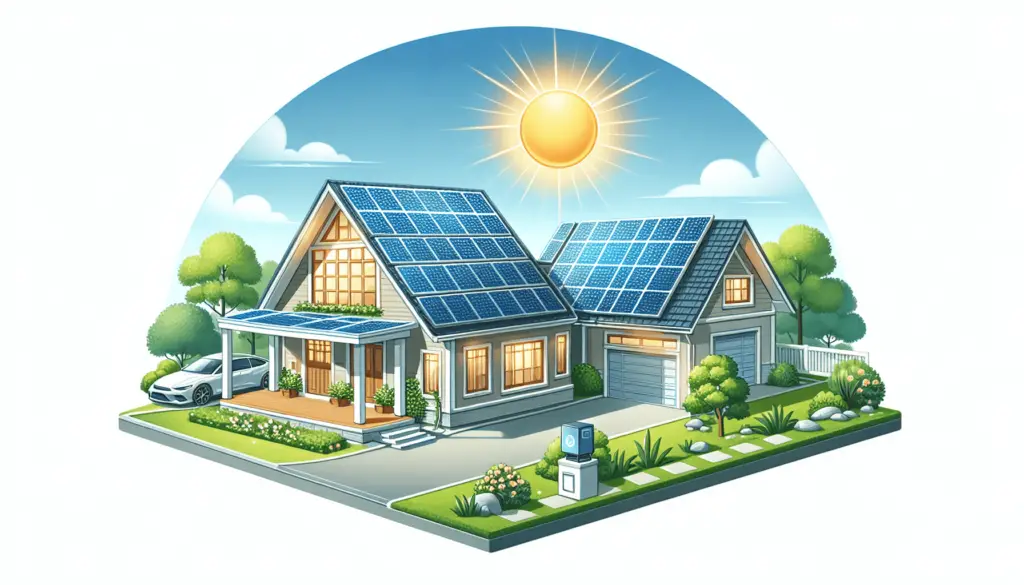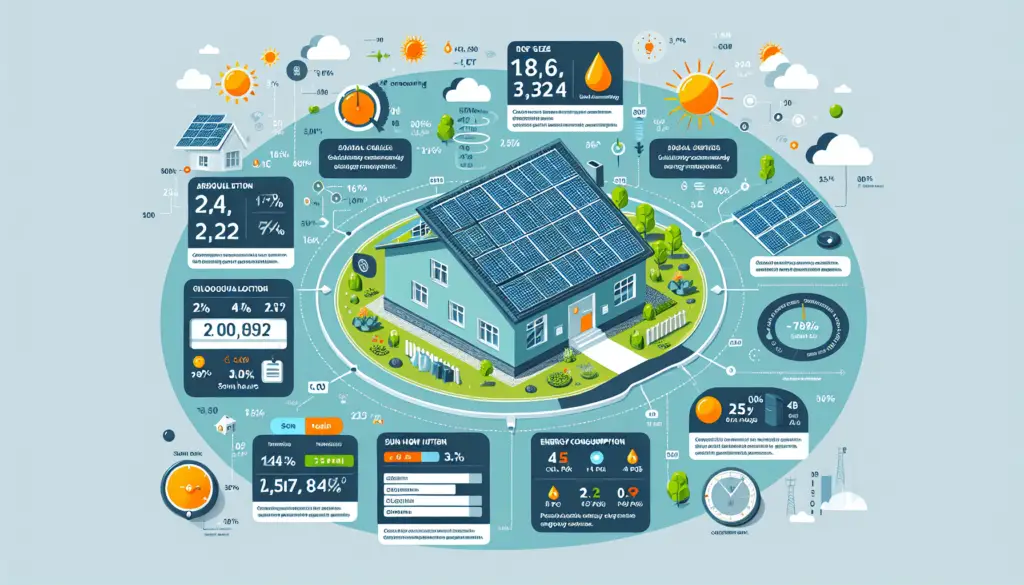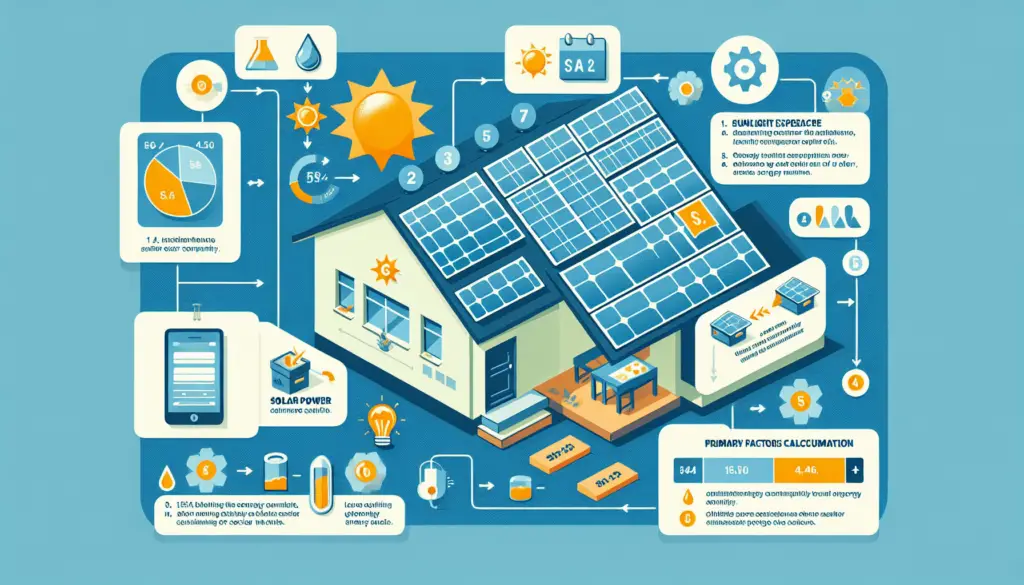Thinking about going solar? Want to know how much solar power your home needs? Look no further! In this article, we will guide you through the steps to calculate your home’s solar power needs. From determining your energy usage to considering factors like location and sunlight hours, we’ve got you covered. By the end, you’ll have a clear understanding of how much solar power your home requires and be one step closer to harnessing the power of the sun! So let’s get started and unlock the potential for a greener, more sustainable future right at home.
Understanding Your Electricity Usage
When it comes to transitioning to solar power for your home, the first step is to understand your electricity usage. This will help you determine the appropriate size and capacity of your solar panel system. To get started, gather your recent electricity bills from the past year. These will provide valuable insights into your electricity consumption patterns. Look for the kWh (kilowatt-hour) usage on your bills, which represents the amount of electricity you use in a given period.
Once you have your electricity bills, calculate your average daily electricity usage. To do this, add up the total kWh consumption for the entire year and divide it by 365. This will give you an estimate of how much electricity you use on a typical day. Keep in mind that your daily energy needs may vary depending on factors such as the number of occupants in your home, the appliances you use, and your lifestyle.
It’s important to also consider the seasonal variations in your electricity usage. During certain times of the year, you may consume more electricity due to factors like air conditioning in the summer or heating in the winter. By analyzing your bills and identifying these patterns, you can better understand your energy needs throughout the year and ensure that your solar panel system can meet your requirements.
Assessing Your Energy Goals
Determining your energy goals is crucial in planning your solar power system. Take some time to think about why you want to go solar and what you hope to achieve. Are you looking to reduce your carbon footprint, save money on your electricity bills, or achieve energy independence? Understanding your objectives will help guide your decision-making process and enable you to prioritize the right energy efficiency measures for your home.
Evaluate potential energy efficiency measures that can further reduce your energy consumption. Consider upgrading to energy-efficient appliances, installing LED lighting, or improving insulation in your home. These measures can help minimize your electricity usage and allow your solar panel system to meet your energy goals more effectively.

Estimating Sunlight Availability
To determine the feasibility of a solar panel system for your home, you need to estimate the sunlight availability in your location. Identify your location’s average sunlight hours per day. The more sunlight your area receives, the more energy your solar panels can generate. This information can typically be obtained from meteorological sources or consulted with solar professionals familiar with your area.
In addition to sunlight hours, consider any obstacles or shading that could affect the performance of your solar panels. Trees, nearby buildings, or structures can cast shadows on your panels and reduce their efficiency. Assess the potential for shade throughout the day and year, and if possible, make adjustments to maximize your solar exposure.
It’s also important to factor in the climate conditions of your area. Some regions may experience cloudy or overcast weather more frequently, impacting the amount of sunlight available for your solar panels. Evaluate historical weather data and consult local experts to gain a better understanding of how weather patterns might affect the performance of your solar panel system.
Calculating Your Solar Panel Capacity
To determine the appropriate solar panel capacity for your home, you need to consider your desired level of energy independence and your average daily energy consumption. Think about how much of your electricity needs you want to fulfill with solar power. Do you want to offset a certain percentage of your consumption or go completely off-grid? This will help determine the size of the solar panel system you need.
Calculate your average daily energy consumption by multiplying your average daily electricity usage (in kWh) by a factor that represents the efficiency of your solar panels. This factor varies depending on factors such as location and solar panel technology. A common efficiency factor is around 75%, meaning that you can expect your solar panels to generate about 75% of their rated capacity. By multiplying your average daily electricity usage by this factor, you can estimate the capacity of your solar panel system.
Take into account losses in conversion and storage when estimating the required solar panel capacity. These losses can occur during the conversion of solar energy to electricity (solar panel efficiency) and during the storage of electricity in batteries (battery efficiency). Higher efficiency solar panels and batteries will minimize these losses and allow you to optimize your system’s capacity.

Sizing Your Battery Storage
Energy storage is an integral part of many solar power systems, allowing you to store excess electricity generated during the day for use during the night or times of high demand. To size your battery storage properly, you need to assess your energy storage needs. Consider how much electricity you want to store and for how long. This will depend on factors such as your daily energy consumption, your desired level of energy independence, and the availability of backup power sources.
Factor in the depth of discharge (DoD) when sizing your battery storage. DoD refers to the amount of usable energy that can be extracted from a battery before it needs to be recharged. It’s important to avoid discharging your batteries too deeply, as this can shorten their lifespan. Aim for a DoD of 50% or less to ensure optimal battery performance and longevity.
Inefficiencies in charging and discharging processes can also affect the amount of usable energy stored in your batteries. These inefficiencies can be caused by factors such as heat generation during charging/discharging or losses in the power electronics. Take these factors into account to ensure that your battery storage can meet your energy requirements effectively.
Considering System Voltage
When designing your solar power system, you need to consider the voltage level at which it will operate. Evaluate the benefits and limitations of low voltage and high voltage systems to determine which is most suitable for your needs.
Low voltage systems typically operate at 12V or 24V and are commonly used for small-scale solar power systems. They are simpler and less expensive to set up but may have limitations in terms of the maximum power they can deliver and the distance over which they can transport electricity.
High voltage systems, on the other hand, operate at voltages such as 48V or higher and are generally used for larger-scale solar power systems. These systems can transport power over longer distances and handle higher power loads. However, they require additional safety precautions and may be more complex to install and maintain.
Assess your specific requirements and consult with solar professionals to determine whether a low voltage or high voltage system is more appropriate for your solar power needs.

Understanding Inverter Capacity
Inverters are essential components of solar power systems as they convert the direct current (DC) electricity generated by solar panels into the alternating current (AC) electricity used in your home. When calculating your solar power needs, you should consider the capacity of your inverter to ensure it can handle your maximum AC load.
Calculate your maximum AC load by identifying the appliances and devices that consume the most electricity in your home and determining their power ratings in watts. Sum up the power ratings of these appliances to estimate your maximum AC load.
Factor in efficiency and safety margins when determining the capacity of your inverter. Inverters generally have an efficiency rating that represents how effectively they convert DC electricity to AC electricity. A safety margin should also be considered to allow for any future upgrades or changes in your electricity consumption patterns.
Evaluating Installation Space
When planning your solar panel system, it’s important to assess your available roof area for installation. The size and orientation of your roof will determine the number of solar panels you can install. Measure the dimensions of your roof and consider any obstructions such as chimneys, vents, or dormers that may limit the available space.
If your roof is not suitable for solar panel installation, explore alternative mounting options such as ground-mounted systems or solar canopies. Ground-mounted systems can be installed in your yard, while solar canopies can be built as standalone structures. These alternatives can provide flexibility in terms of installation space and maximize solar exposure.

Obtaining Professional Advice
While it’s possible to gather information and make calculations on your own, it’s always a good idea to consult with solar installers and seek expert opinions. Professional advice can help you better understand the specific requirements and considerations for your solar power needs. Installers can assess your home’s characteristics, evaluate potential challenges, and provide customized recommendations to ensure the success of your solar panel system.
Don’t hesitate to ask questions and seek clarification on any aspects that you’re unsure about. Solar installers have the expertise to guide you through the entire process, from system design and installation to maintenance and troubleshooting. Their insights and knowledge will help you make informed decisions and ensure that your solar power system meets your expectations.
Using Online Solar Calculators
If you want to explore your solar power needs further, you can also utilize online solar calculator tools. Research reliable calculators that take into account various factors such as location, energy consumption, sunlight availability, and system efficiency. These tools can provide estimates and insights into the size and capacity of the solar panel system you need.
To use an online solar calculator, input your home’s relevant information, including your location, energy consumption, available roof area, and any shading or obstacles. The calculator will process this data and generate results that indicate the recommended system size, average energy production, and potential cost savings.
Analyze the results provided by the solar calculator and compare them with your energy goals and objectives. Keep in mind that these calculations are estimates, and it’s always recommended to consult with professionals to validate and fine-tune your solar power system planning.
By following these steps and considering various factors, you can accurately calculate your home’s solar power needs. With the right system size, capacity, and configuration, you can harness the sun’s energy to power your home more sustainably and efficiently.
